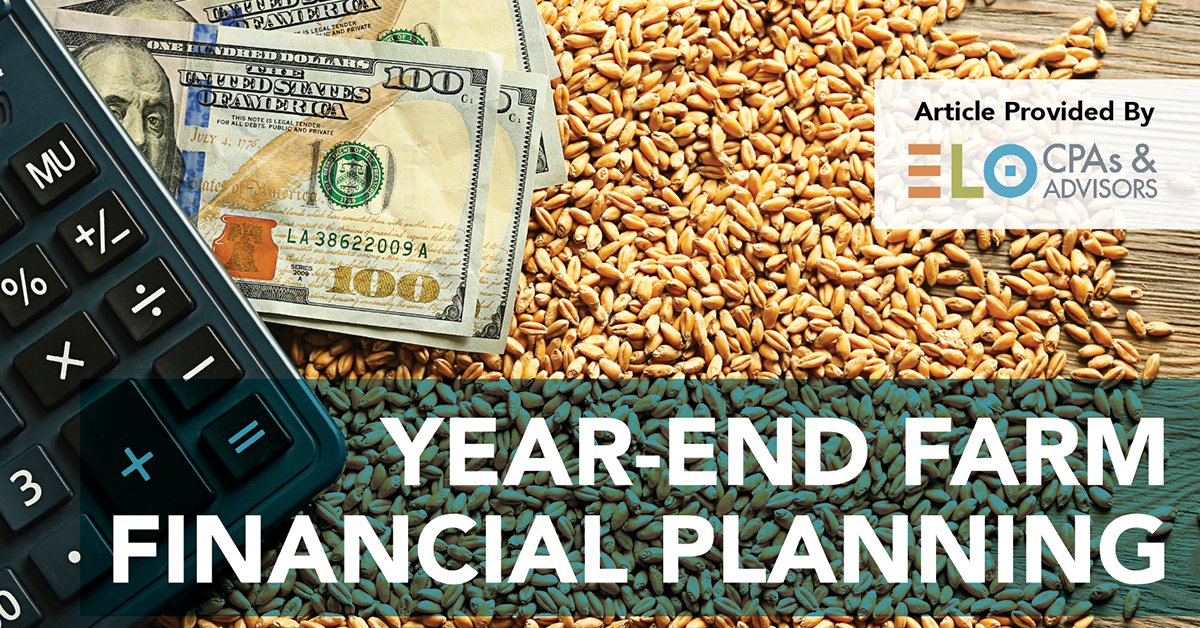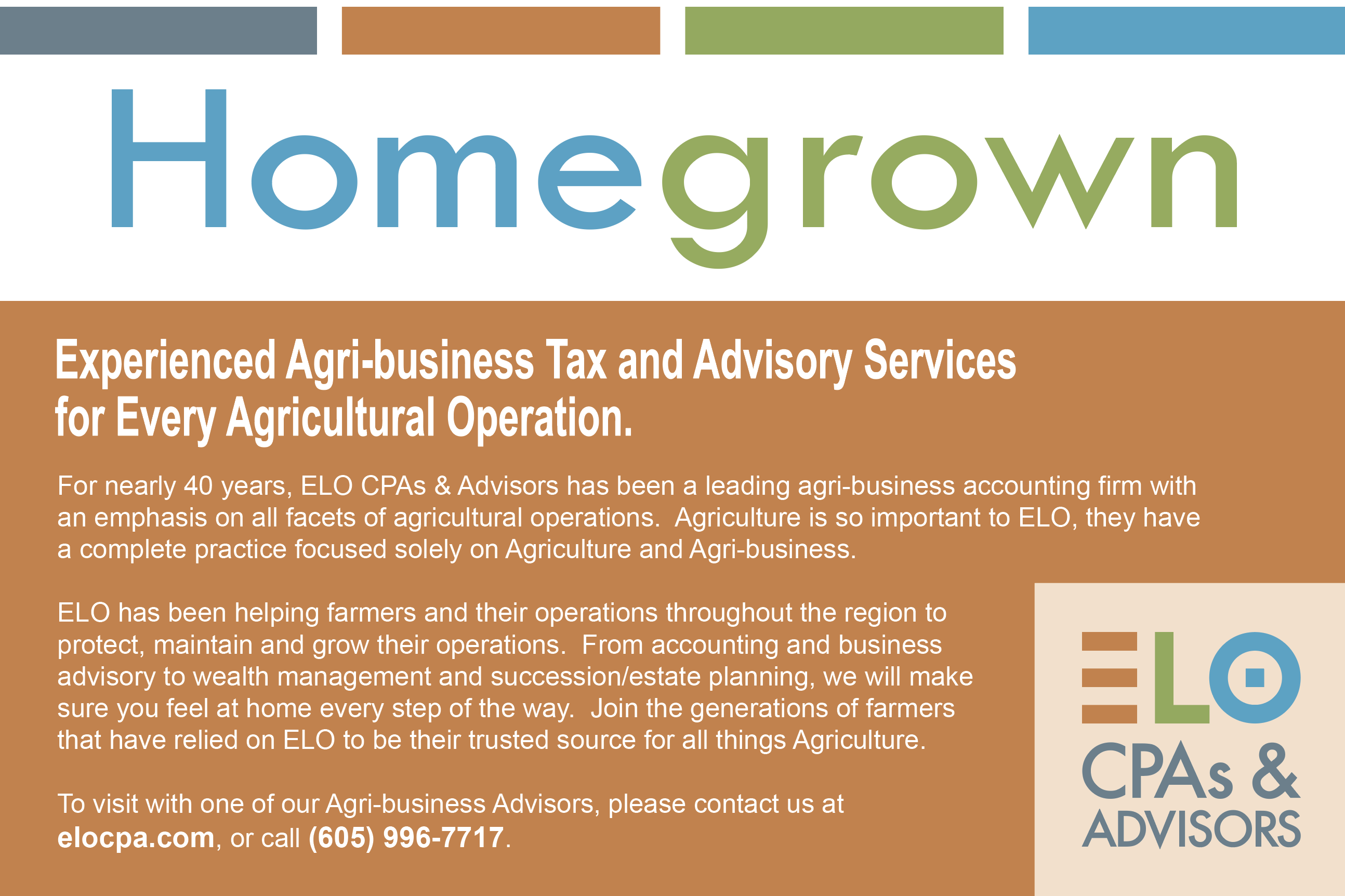
Another year has come and gone. The crop is in the bin, the hay is in the barn, and the cows are home. You may be thinking it’s time to relax. However, much of the operation’s most important and impactful work is still ahead before year-end. Just like the equipment gets cleaned up, repaired, and maintained, the same time and care needs to be given to the farm’s year-end financial planning. Your farm’s year-end financial planning may include accounting and tax planning, accrual and balance sheet analysis, financial advisor and lender meetings, business risk identification and planning, and succession and estate planning.
 Accounting:
Accounting:
The foundation to the farm’s year-end financial planning is having the farm’s accounting records up to date and correct. Without this information, the operation can’t move on to the next steps. Ensure that all transactional data is inputted and reconciled, gather all equipment purchase and sale documentation, livestock sale records, and any other items you regularly provide to your CPA. Contact your accounting firm and get your books in order.
Tax Planning:
Once your accounting records are in order, schedule a time with your CPA to create a year-end tax plan. Farms have tremendous flexibility in the way they report taxable income, which makes this meeting so valuable. The role of the CPA in this situation is to maximize tax efficiency while considering its effects on the farm’s cash flow, balance sheet, and business needs. The farm makes an amount of income over a course of years based on its operations, but the way that income is reported over the years on the tax returns can have a dramatic effect on the tax cost of that income. Tax reporting for the farm can be complicated as in most cases there is a three-year overlap of operations reported in the same year. Because of this, the tax planning process should be taken with care and consideration. Your farm’s CPA should have a grip on the farm’s accrual basis income, working capital position, expected capital asset purchases, and other significant business plans in order to come up with an effective tax plan. Anyone can advise on how to lower taxable income on the farm on a particular year, but there are few that can put together a comprehensive plan that considers and optimizes the whole financial picture of the farm. Consider inviting your lender and marketing advisor to participate in this meeting to help everyone gain a holistic view of the farm. Tax planning is a high return on investment job on the farm.
Accrual Analysis:
After taking care of the ABCs for the farm’s accounting, accrual analysis can be completed to take your farm’s utilization of its financial data to the next level. Accrual basis income will tell you how much money the farm made or lost in a given year. Because of farming’s unique production and cash flow cycles, this can be a tough number to understand without accrual analysis. Despite its benefits, very few farms track profits and losses on an accrual basis so by doing so your operation will gain a competitive advantage. Accrual analysis allows the farm to analyze the actual financial health of the operation as profitability and ratio analysis can be completed. Different ratios will be important to the farm based on where it’s at in its financial journey. The important metrics to a business are referred to as Key Performance Indicators (KPIs). There are many farm financial ratios out there, but choosing 3-5 key ratios or KPIs for your farm will provide the highest return on your analysis by not getting in the weeds which can easily happen in ratio analysis. Tracking profitability, working capital position as a percent of expenses, revenues, and per acre, and the debt service coverage ratio will serve most farms well. These three combined will tell the operation if it’s making or losing money (profitability), its ability to absorb a tough year and capture future opportunities (working capital position), and if it’s creating enough cash flow to support the amount of leverage in the operation (debt service coverage ratio). To sum it up, they provide the operation with the information of whether it can sustain and continue to farm year after year. Mature operations may focus on other metrics such as return on equity, return on assets, true economic profit by assigning a fair market rent charge to their owned land, or to analyze their working capital to give them information on how much money they can distribute out of the farming operation. The important thing is to start with a few key ratios that matter to your farm. It may sound complicated, but this analysis simplifies the way you can look at the farm’s finances.
Lender Meeting:
The year-end bank meeting is a meeting that can either cause a lot of stress for an operation or be another opportunity to strengthen its relationship with its lender. An important question for you to consider in your lending relationship is whether you are working for the bank or is the bank working for you? The answer to that question will determine whether you are a desirable borrower for the bank. Being proactive in your communication with your lender and by providing solid information through accounting records, completed accrual analysis, and having a tax plan will greatly increase your odds of having a successful borrower-lender relationship, which will help create additional opportunities for the operation.
Financial Advisor:
After working through the nuts and bolts of the farm’s accounting and finances, take time to schedule a meeting with your financial advisor. Many farmers don’t have financial assets invested outside the farm, but there are benefits to diversifying your wealth through off-farm investments. Starting to build these assets early in life helps to provide another income stream in retirement, and it will aid in the succession of the farm. There are many tax-advantaged savings vehicles to use such as IRAs, SEP IRAs, 401(k) plans, and defined benefit plans that lower taxable income and provide tax sheltered growth. Also review if you have adequate levels of life insurance and if you have a right mix of term and whole life to fulfill your goals. Dr. David Kohl, professor of Agricultural Finance at Virginia Tech, suggests that farmers should be planning to have 50% of their retirement income to come from off-farm investments. This diversification of assets creates security for the retiring generation and opportunity for the incoming generation.
Risk Identification & Planning:
What things cause you to lay awake at night and lose sleep? Take some time to list out the risks that effect your farm and put them into two categories: ones that you can control and ones that are out of your control. Doing this will provide clarity on steps you can take to reduce risk in your farm. Some financial risk questions to ask and address are: Do you know where the farm’s finances will be if the farm has the worst possible year next year? Does the farm have enough working capital in place to absorb that set back? If not, is there something you can do right now to raise working capital and is there a plan in place with your lender if that scenario does take place? Does your operation have a marketing plan in place to secure the revenue it needs to continue? Your operation also has management risk to deal with as the risks to your business stem farther than just direct financial risks. What happens if the main decision maker gets hit by a bus? Are there proper legal, succession, and estate plans in place for the farm to continue? Are there documented policies and procedures in place for the duties carried out by the main manager or is everything in “their head”? Is there someone else in the operation that understands the interworking’s of the farm? Are you taking care of your health and mental well-being so you can carry out your duties in the farm? Farming is a risky business, making it critically important to reduce the risks that are within your control.
Succession and Estate Planning:
Risk identification and planning may identify that the farm has gaps in its succession and estate plan. These plans take time to develop so it’s critical to not delay the process. If you do have a plan in place, when was the last time you addressed and reviewed if there are any additions or changes that should be made? Succession and estate planning often get lumped into the same bucket, but it’s important to note that they are two different processes that require different planning. Succession planning is the process of transferring over management responsibilities and possibly ownership percentage in the farm operating entity during life while estate planning is the transfer of assets. Assembling your team of advisors and starting the conversation early is the key to success. It’s important to assemble a team that not only understands the technical tools such as entity structure, gifting, estate and tax laws, but a team that understands the complexity of the human elements that are at play in a farm succession plan. Understanding the human and relationship dynamics at play within the plan is what will ultimately make or break the tools that get used to carry out the succession. Work with advisors that are willing to listen, ask good questions, and gain an understanding of the ultimate end goal of the farm before formulating a plan to get there.
----
Year-end planning involves many tasks that need to be given the same care as other jobs on the farm because they can truly make or break all the work you have done on the farm for the year. This is the perfect time to work on the business. Treat your farm like a business and it will pay dividends for yourself and generations to come.





